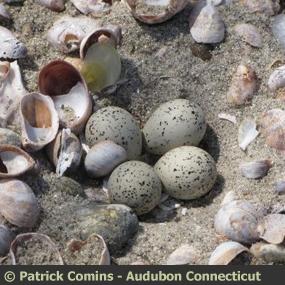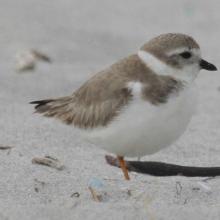

Join BirdNote tomorrow, November 30th!
Illustrator David Sibley and actor H. Jon Benjamin will face off in the bird illustration battle of the century during BirdNote's Year-end Celebration and Auction!
Young Piping Plovers hatch in early summer, in competition for use of the beach. Patrick Comins, Director of Conservation for Audubon Connecticut, says if there were no fences or exclosures, it would be very easy to step on the eggs. "You can hardly see them. We have to put up little cages around them called 'exclosures' that keep things like gulls and crows and foxes and raccoons out of the cage." But as soon as the birds hatch, they're running around on their own - they're like cottonballs on legs. Share the beach with plovers!
BirdNote®
Piping Plovers Nest on the Beach -
Interview with Patrick Comins by Chris Peterson
This is BirdNote!
[Call of Piping Plover and waves]
If you visit a sandy beach this month along the Great Lakes, or the Atlantic from North Carolina to Newfoundland, keep an eye out for one of nature’s most appealing avian fuzzballs.
[Call of Piping Plover and waves]
Young Piping Plovers are hatching about now, unaware their parents have put them in competition for use of the beach. Patrick Comins, Director of Conservation for Audubon Connecticut, takes us to Long Beach, in Stratford, near the busy city of Bridgeport. Here’s how people are helping the rare and endangered Piping Plover:
G15 T22 …They’re really amazing to watch. They nest right here on the beach [big truck going by] right on the ground, they don’t make a nest, that’s one of the reasons why you need to have controlled access around ‘em because if there were no fences or no exclosures whatsoever it would be very easy to step on the eggs… you can hardly see them … and also they’re subject to predation, so we have to put up little cages around them called exclosures that keep things like gulls and crows and foxes and raccoons out of the cage… But as soon as the birds hatch, they’re running around on their own – they’re like little cottonballs on legs. The parents don’t feed them at all; they go right from day one they’re off feeding themselves. The only care the parents give them is to alert them to dangers – if they see a hawk flying over …
[Call of Piping Plover and waves]
G15T22 cont…They have this fascinating behavior and they’re just really a joy to watch … and I think that as more and more people get exposed to this they’ll understand why it is that we need to give them a little room and share the beach with them.
[Call of Piping Plover and waves]
There’s more to this story, and photos, at birdnote.org. Today’s show brought to you by the Lufkin Family Foundation.
###
Calls of the Piping Plover provided by The Macaulay Library of Natural Sounds at the Cornell Lab of Ornithology, Ithaca, New York; recording 38413 by Dolly Minus.
Producer: John Kessler
Executive Producer: Chris Peterson
© 2011 Tune In to Nature.org June 2011 Narrator: Mary McCann
ID# SotB-PIPL-01-2011-06-24







